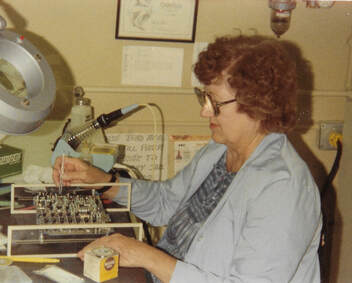archive
My mother, the whistleblower
In 1957, after her divorce, my mother Lillian began working for Gilfillan Brothers in Los Angeles as an electrical and mechanical assembler in their Radar Production Department. From there, she went a couple of years later to North American Aviation in Downey, California, where she worked as an electronic assembler on parts for military jets.
At North American she claimed that faulty components were being approved despite her objections. Looking back, these might have been shortcuts taken to increase profits but at the time my mother believed this was part of a communist plot to sabotage U.S. jets and she reported it to the FBI, which interviewed her. Apparently, nothing came of the investigation and she was fired and blacklisted from the industry.
Meanwhile, she had decided to take her complaints to a higher authority. She had heard that President Kennedy was visiting actor Peter Lawford at his Santa Monica beach home. With me in tow (I was 10 years old), we went to a Catholic Church in Santa Monica. As I waited in the car, she went inside where she apparently persuaded a priest to give her Lawford’s address. We drove to a house on the beach. Again, as I waited in the car, she went up to the door and rang the bell. No one answered. We drove back home.
In 1957, after her divorce, my mother Lillian began working for Gilfillan Brothers in Los Angeles as an electrical and mechanical assembler in their Radar Production Department. From there, she went a couple of years later to North American Aviation in Downey, California, where she worked as an electronic assembler on parts for military jets.
At North American she claimed that faulty components were being approved despite her objections. Looking back, these might have been shortcuts taken to increase profits but at the time my mother believed this was part of a communist plot to sabotage U.S. jets and she reported it to the FBI, which interviewed her. Apparently, nothing came of the investigation and she was fired and blacklisted from the industry.
Meanwhile, she had decided to take her complaints to a higher authority. She had heard that President Kennedy was visiting actor Peter Lawford at his Santa Monica beach home. With me in tow (I was 10 years old), we went to a Catholic Church in Santa Monica. As I waited in the car, she went inside where she apparently persuaded a priest to give her Lawford’s address. We drove to a house on the beach. Again, as I waited in the car, she went up to the door and rang the bell. No one answered. We drove back home.
We took a six-month hiatus to visit relatives in Texas. My mother changed our last name and after obtaining electronic assembly training at a community college, my mother obtained a job at Lockheed in 1964. From there she went to Odetics in Anaheim, where she worked on robotics and recording devices for the space shuttle program, including work on the ill-fated Columbia shuttle. She obtained several commendations and awards at both Lockheed and Odetics. She retired in 1988 and died in 2005.
Images Depósito del Archivo de la Fundación Sierra-Pambley, Archivo-FSP, CC BY-SA 4.0; Lillian Urbanek at Odetics, collection of Robert Urbanek
© Robert S Urbanek
